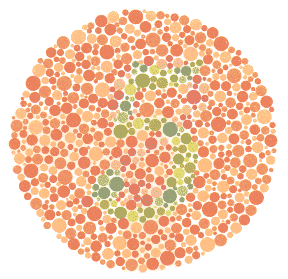
Color blindness is a common vision problem that roughly affects 1 in 12 men and 1 in 200 women. But what is it, and why does it happen?
Color blindness is a condition in which people have a reduced ability or, rarely, a complete inability to distinguish certain colors. Color blindness is often passed down from generation to generation. A few other possible causes are various eye diseases and specific medications.
Color blindness is far more common in men than in women. This is because colorblindness is a recessive gene passed down along the X chromosome. Males have one X chromosome, and females have 2. That gives females twice as much chance for the dominant color-seeing gene to appear.
Types of Color Blindness
Full color blindness is called complete achromatopsia. It’s extremely rare but is the most common form depicted in media. People with this form of color blindness see the world in shades of gray, black, and white.
In real life, you’re more likely to encounter someone with partial achromatopsia. Partial achromatopsia isn’t seeing a certain color as gray. Rather, it’s the inability to tell two colors apart (especially when placed next to each other).

What do you see in this image? Is it a cluster of red and red-orange dots? Is it a cluster of green dots? Or do you see the number five made of green dots surrounded by red and orange dots?
This image is called the Ishihara color test, and chances are you’ve seen it before. It is one of the most commonly used color blindness tests eye care professionals choose. It tests for red-green color deficiencies. Invented by Shinobu Ishihara, the test’s namesake, it was first published in the University of Tokyo in 1917.
Red-Green Color Blindness
The two most common colors that people struggle with are red and green. There are four different kinds of red-green color blindness: deuteranomaly, protanomaly, and protanopia and deuteranopia.
Deuteranomaly is the most common form of red-green color blindness and makes greens look like they have a redder hue. It’s probably the mildest form of color blindness and almost never gets in the way of everyday activities.
Protanomaly is the opposite of deuteranomaly. It causes reds to look like they have a greener hue to them and also doesn’t tend to interfere with daily life. Much like deuteranomaly, it is very mild.
Protanopia and deuteranopia are the rarer forms of red-green color blindness. Protanopia is a decreased ability to register red light, causing the person to mistake reds and oranges for greens. Deuteranopia is the opposite. It’s the inability to process green light and makes greens look like reds and oranges.
Blue-Yellow Color Blindness
Blue-yellow color blindness is less common than its red-green counterpart. Blue-yellow color blindness is caused by problems with the eyes’ S-cones. There are two subcategories of blue-yellow color blindness, called tritanomaly and tritanopia.
Tritanomoly is the inability to differentiate between blue and green or yellow and red. Tritanopia is more complex. It gives you an inability to tell the difference between blue and green, purple and red, and yellow and pink. It can also make colors look less bright in general.
Can Color Blindness be Cured?
Color blindness (typically diagnosed using the Ishihara test shown above) typically runs in a family, and as of now, it has no cure. There are, however, a few temporary treatments. Contact lenses and glasses are available to help color blind people filter colors. Most people with color blindness are able to go about their day without any struggle, but sometimes they need special accommodations.
When you do get your prescription for color-filtering lenses, WebEyeCare has a wide variety of designer eyeglass and sunglass frames for you to choose from. We work with dozens of brands like Ray-Ban, Burberry, Jimmy Choo, Versace, Vera Wang, and Nike.
We also offer online virtual vision tests for Eyeglasses and Contacts. Now you can get your prescription renewed from the safety and comfort of your own home. Our online eye exams are not a substitute for an in-person visit with your eye care professional. You should always make routine visits to your eye doctor as recommended to ensure optimal eye health.
If glasses and sunglasses aren’t your style, we have a variety of brands of contacts available, both prescription and colored lenses. You can take your pick from brands like Acuvue, Air Optix, Biofinity, and many more!
We look forward to becoming your one-stop shop for all of your vision care needs.
 Save yourself from getting into rush hours and buy your contacts online.
Save yourself from getting into rush hours and buy your contacts online.








